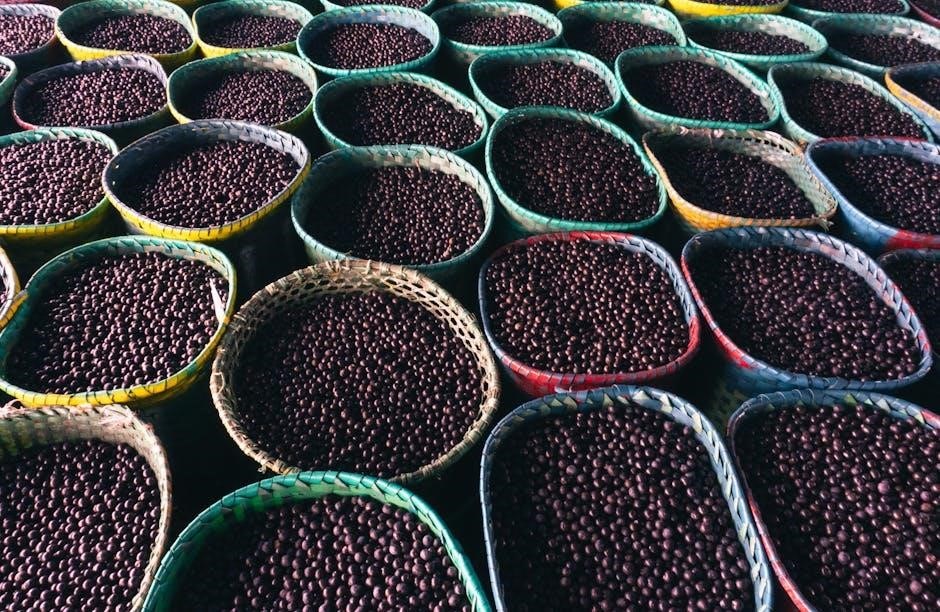Handicrafts for the elderly are a gateway to creativity, social interaction, and emotional well-being․ They reduce stress, improve motor skills, and provide a sense of accomplishment through activities like painting and crafting․
Importance of Creativity in the Golden Years
Creativity plays a vital role in the emotional and mental well-being of seniors․ Engaging in handicrafts fosters self-expression, reducing stress and anxiety while boosting mood․ Activities like painting, knitting, or embroidery provide a sense of accomplishment and purpose, enhancing self-esteem․ Creativity also stimulates memory and concentration, offering therapeutic benefits for conditions like Alzheimer’s or depression․ By exploring artistic interests, seniors can maintain cognitive function and embrace a fulfilling lifestyle․ These activities not only promote relaxation but also offer opportunities for social interaction, making them a cornerstone of holistic well-being in the golden years․
How Handicrafts Promote Social Connection
Handicrafts serve as a powerful tool for fostering social interaction among seniors․ Group activities like knitting, embroidery, or painting encourage collaboration and shared creativity, helping to build strong bonds․ Working together on projects creates opportunities for conversation and mutual support, reducing feelings of loneliness․ The shared joy of creating something meaningful strengthens relationships and fosters a sense of belonging․ Additionally, participating in group handicraft sessions provides a platform for storytelling and shared experiences, enriching emotional connections․ These activities not only promote mental well-being but also help seniors stay engaged with their community, combating isolation and enhancing their quality of life․

Benefits of Handicrafts for Seniors
Handicrafts offer numerous benefits for seniors, including improved motor skills, reduced stress, and enhanced mental clarity․ They foster creativity and provide a sense of accomplishment, boosting overall well-being․
Physical Benefits: Improving Dexterity and Motor Skills
Handicrafts significantly enhance physical abilities in seniors by improving dexterity and motor skills․ Activities like knitting, painting, and clay modeling strengthen hand-eye coordination and fine motor functions, reducing the risk of conditions such as arthritis․ Engaging in these crafts requires precision and repetitive movements, which help maintain muscle tone and flexibility․ Additionally, the use of tools like brushes, needles, and scissors can prevent muscle atrophy, keeping hands active and nimble․ Regular participation in such activities contributes to overall physical well-being and independence, making them an essential part of a healthy lifestyle for seniors․
Mental and Emotional Benefits: Reducing Stress and Boosting Mood
Engaging in handicrafts offers profound mental and emotional benefits for seniors, serving as a natural stress reliever and mood booster․ Activities like embroidery, origami, and painting foster creativity, providing a sense of accomplishment and purpose․ The focus required during these tasks distracts from daily worries, promoting relaxation and reducing anxiety․ Additionally, the creative process stimulates the release of endorphins, which enhance overall mood and emotional well-being․ Handicrafts also provide an outlet for self-expression, helping seniors cope with feelings of loneliness or isolation․ This emotional upliftment is crucial for maintaining a positive outlook and mental health in the golden years․
Cognitive Benefits: Enhancing Memory and Concentration
Handicrafts play a vital role in enhancing memory and concentration among seniors․ Activities like painting, embroidery, and origami challenge the brain, promoting mental sharpness and focus․ Repetitive motions in knitting or crochet aid in memory retention, while creative tasks stimulate problem-solving skills․ These exercises help maintain active neuronal connections, reducing cognitive decline risks․ Additionally, the structured nature of handicrafts provides a sense of accomplishment, boosting confidence and mental agility․ Regular engagement in these activities not only strengthens memory but also supports overall brain health, making them a valuable tool for cognitive well-being in the elderly․
Popular Handicraft Activities for Seniors
Engaging in creative activities like painting, knitting, embroidery, origami, and clay modeling fosters creativity and well-being․ These hobbies are ideal for seniors, promoting relaxation and skill development․
- Painting
- Knitting and crochet
- Embroidery
- Origami
- Clay modeling
Painting: Exploring Colors and Techniques
Painting is a therapeutic and creative outlet for seniors, allowing self-expression and relaxation․ Watercolor, acrylic, and oil painting are popular techniques that stimulate imagination and fine motor skills․ This activity fosters calmness, focus, and a sense of accomplishment․ Seniors can explore vibrant colors and textures, creating meaningful art that reflects their experiences and emotions․ Painting classes or guided sessions can be adapted to skill levels, making it accessible for everyone․ The process of bringing ideas to life on canvas enhances cognitive function and provides a fulfilling hobby that combats stress and isolation, promoting overall well-being in the golden years․
Knitting and Crochet: Creating Useful Items
Knitting and crochet are rewarding handicrafts for seniors, offering relaxation and a sense of accomplishment․ These activities improve hand-eye coordination and dexterity while creating practical items like blankets, clothing, or home decor․ The repetitive motions are soothing, reducing stress and fostering calmness․ Seniors can work on projects at their own pace, enjoying the satisfaction of creating something useful․ Group sessions also encourage social interaction and camaraderie․ Easy-to-handle tools and adaptable patterns make these crafts accessible for those with physical limitations, providing a therapeutic outlet and a way to contribute to others through handmade gifts․ These activities promote both creativity and purpose․
Bordado: The Art of Embroidery
Embroidery is a traditional craft that offers relaxation and artistic expression for seniors․ Using needles, threads, and fabrics, it enhances fine motor skills and cognitive function․ The repetitive stitching motions are calming, reducing stress and anxiety․ Embroidery allows seniors to create personalized designs, fostering creativity and a sense of accomplishment․ It can be adapted to different skill levels, making it accessible for those with physical or cognitive limitations․ This therapeutic activity not only preserves cultural heritage but also provides a medium for self-expression․ Many find joy in creating decorative items or gifts, boosting self-esteem and providing a lasting sense of purpose․
Origami: The Therapeutic Art of Paper Folding
Origami is a meditative activity that brings calmness and focus to seniors․ This traditional art of paper folding enhances dexterity and hand-eye coordination while stimulating the mind․ Simple designs, like folding animals or flowers, are accessible for seniors, providing a sense of achievement․ Origami’s repetitive motions are soothing, reducing stress and anxiety․ It also sharpens memory and concentration, making it an excellent cognitive exercise․ This creative outlet encourages patience and perseverance, offering a therapeutic escape․ Many seniors find joy in creating intricate yet delicate shapes, fostering a sense of pride and accomplishment with each completed piece․ It’s both a hobby and a mindful practice․
Clay Modeling: Sculpting and Shaping
Clay modeling is a versatile and therapeutic activity for seniors, offering a creative outlet while improving motor skills and cognitive function․ Shaping clay enhances hand dexterity and coordination, making it an excellent exercise for maintaining physical agility․ It also fosters focus and concentration, stimulating the mind and reducing stress․ Seniors can create decorative items, sculptures, or functional objects, experiencing a sense of accomplishment with each finished piece․ The tactile nature of clay provides a calming and grounding experience, allowing for self-expression and emotional well-being․ This activity is adaptable to different skill levels, making it accessible and enjoyable for all elderly participants․

Adapting Handicraft Guides for Seniors
Adapting guides involves simplifying processes, using clear language, and incorporating visuals․ Tools and materials must be easy to handle, with patience and support provided throughout the activity․
Simplifying Processes for Easy Understanding
Simplifying processes ensures that seniors can follow instructions effortlessly․ Breaking tasks into small, manageable steps reduces complexity and enhances comprehension․ Using clear, concise language and visual aids further aids understanding, making the activity enjoyable and stress-free․
Using Clear Language and Visual Aids
Clear language and visual aids are essential for guiding seniors through handicraft activities․ Simple, jargon-free instructions paired with images or diagrams help ensure understanding․ Visual demonstrations of each step make tasks more accessible and less intimidating, fostering confidence and engagement․
Choosing Appropriate Tools and Materials
Selecting the right tools and materials is crucial for seniors․ Lightweight, ergonomic tools and non-toxic supplies ensure safety and comfort․ Materials should be easy to handle, durable, and adaptable to physical limitations․ This promotes independence and enjoyment in crafting activities․
Considering Physical and Cognitive Limitations
When adapting handicrafts for seniors, it’s essential to consider physical and cognitive limitations․ Activities should be tailored to individual abilities, ensuring they are accessible and enjoyable․ Simplifying tasks and using larger, easier-to-handle materials can accommodate dexterity challenges․ For those with cognitive impairments, breaking projects into smaller, manageable steps is beneficial․ Visual aids and clear instructions help guide participants․ Adaptive tools, like ergonomic handles or pre-cut shapes, can enhance ease of use; Prioritizing safety and comfort ensures seniors can engage without frustration, fostering creativity and confidence despite any limitations․
Providing Patience and Support
Providing patience and support is crucial when engaging seniors in handicrafts․ Encouraging a calm and non-pressured environment allows them to explore creativity at their own pace․ Caregivers and instructors should offer positive reinforcement, celebrating progress and effort rather than perfection․ This fosters confidence and enjoyment․ Additionally, being patient with physical or cognitive challenges helps seniors feel comfortable and motivated․ Supportive guidance ensures they can navigate tasks successfully, making the experience rewarding and fulfilling․ Patience and encouragement are key to helping seniors thrive in handicraft activities, promoting a sense of accomplishment and emotional well-being․

Handicrafts as Therapy
Handicrafts serve as a powerful therapeutic tool, promoting emotional well-being and mental health in seniors by reducing stress and fostering creativity, confidence, and a sense of purpose․
Art Therapy for Emotional Well-being
Art therapy through handicrafts provides emotional well-being for seniors by reducing stress, anxiety, and depression․ Activities like painting, embroidery, and crafting foster relaxation and a sense of accomplishment, boosting self-esteem and confidence․
Occupational Therapy for Skill Development
Occupational therapy through handicrafts helps seniors develop and maintain essential skills․ Activities like knitting or woodworking enhance fine motor skills, hand-eye coordination, and dexterity․ These exercises also improve memory and concentration, aiding in cognitive function and overall independence, making daily tasks easier․
Using Handicrafts for Stress Relief
Engaging in handicrafts provides seniors with a calming escape, effectively reducing stress and anxiety․ Activities such as painting, embroidery, and origami offer a sense of accomplishment, boosting self-esteem and providing an outlet for personal expression․ The repetitive motions in these crafts can be meditative, fostering relaxation and emotional well-being․ By focusing on the creative process, seniors can distract themselves from daily worries, enjoying a fulfilling and therapeutic experience․ This mental diversion enhances their mood, reduces tension, and contributes to a more balanced and serene life, making handicrafts an excellent tool for stress relief in older adults․
Handicrafts in Rehabilitation and Recovery
Handicrafts play a vital role in the rehabilitation and recovery of seniors, particularly those with physical or cognitive challenges․ Activities like knitting, clay modeling, and origami help restore motor skills, improving dexterity and coordination․ For individuals recovering from injuries or surgeries, these crafts offer a gentle, therapeutic way to rebuild strength; Additionally, the creative process stimulates the mind, aiding in cognitive recovery and memory retention․ The sense of accomplishment from completing a project boosts confidence and morale, making handicrafts an essential tool in holistic rehabilitation․ Engaging in these activities fosters resilience and independence, supporting overall well-being during the recovery process․
Handicrafts for Seniors with Specific Needs
Handicrafts for seniors with specific needs, such as Alzheimer’s or physical disabilities, are tailored to promote accessibility and engagement․ Activities like adapted painting or simplified knitting foster creativity and therapy, ensuring inclusivity and enjoyment for all participants, regardless of their abilities․
Activities for Those with Alzheimer’s or Dementia
Handicrafts for seniors with Alzheimer’s or dementia focus on stimulation and memory retention․ Activities like painting, origami, and simple crafts help reduce stress and provide a sense of accomplishment․ Using recycled materials, such as transforming household items into art, encourages creativity and calmness․ These activities are adapted to individual needs, ensuring accessibility and enjoyment․ They also serve as a form of therapy, helping to maintain neural connections and reduce symptoms of cognitive decline․ The repetitive motions in knitting or the tactile experience of clay modeling can be particularly soothing․ Such creative outlets foster a sense of purpose and emotional well-being․
Handicrafts for Individuals with Physical Disabilities
Handicrafts for individuals with physical disabilities are tailored to enhance accessibility and comfort․ Activities like adaptive knitting with larger needles or lightweight materials are ideal․ Tools with ergonomic handles and non-slip grips reduce strain; Simplified steps and visual guides ensure clarity․ projects like paper folding or embroidery accommodate dexterity limitations․ These crafts foster creativity and confidence, providing a sense of achievement․ They also serve as therapeutic exercises, improving motor skills and mental well-being․ The focus is on adaptability, ensuring each activity suits the individual’s physical capabilities, making the experience enjoyable and fulfilling․
Adapting Handicrafts for Visual or Hearing Impairments
Adapting handicrafts for seniors with visual or hearing impairments involves using tactile guides, large-print instructions, and high-contrast materials․ For visual impairments, tactile-based activities like textured crafts or 3D modeling are ideal․ Audi descriptions and Braille instructions can enhance accessibility․ For hearing impairments, non-verbal communication, such as hand gestures or written guides, ensures clarity․ Assistive devices like magnifying glasses or hearing aids can be incorporated․ Group settings allow for visual or tactile cues, fostering social interaction․ These adaptations enable seniors with sensory limitations to engage creatively, building confidence and fostering a sense of connection․ The focus is on accessibility and inclusivity, ensuring everyone can participate meaningfully․

Engaging Seniors in Outdoor Activities
Outdoor handicrafts, like nature-based projects and garden workshops, encourage seniors to connect with nature while creating art․ Group activities foster social interaction and a sense of community․
Outdoor Crafts and Nature-Based Projects
Outdoor crafts and nature-based projects offer seniors a refreshing way to connect with the environment while fostering creativity․ Activities like creating garden decorations, bird feeders, or flower presses allow them to engage with nature․ Using natural materials such as leaves, branches, and stones inspires unique art pieces․ Group projects, like communal garden art or nature-themed sculptures, encourage collaboration and social bonding․ These activities also promote physical movement and mental relaxation, helping reduce stress․ By transforming natural elements into art, seniors can express their creativity and enjoy the therapeutic benefits of being outdoors․ Nature-based crafts provide a sense of accomplishment and joy․
Group Activities for Social Interaction
Group handicraft activities are an excellent way to promote social interaction among seniors․ Collaborative projects, such as communal quilts or shared art installations, foster teamwork and communication․ Seniors can bond over shared creative interests, reducing feelings of loneliness․ These activities provide opportunities for storytelling and exchanging experiences, enriching emotional connections․ Group settings also encourage mutual support, as participants can assist one another with tasks․ Additionally, celebrating completed projects together boosts morale and creates a sense of community․ Social interaction through group crafts enhances mental well-being and strengthens relationships, making it a vital component of elderly care and engagement․

Handicrafts Using Recycled Materials
Recycled materials inspire creativity and sustainability in elderly handicrafts․ Transforming household items like paper, fabric, and plastic into art fosters eco-friendly practices and stimulates creativity, offering a therapeutic and economical outlet․
Creating Eco-Friendly Crafts
Creating eco-friendly crafts is a rewarding and sustainable activity for seniors․ By reusing materials like paper, fabric, and plastic, elderly individuals can craft unique items while promoting environmental awareness․ This approach fosters creativity and resourcefulness, transforming discarded items into functional or decorative pieces․ Eco-friendly crafts also offer a sense of accomplishment and contribute to a greener lifestyle․ Simple projects include making notebooks from recycled paper, turning old clothes into quilts, or creating jewelry from plastic bottles․ These activities are both cost-effective and mentally stimulating, making them ideal for seniors looking to engage in meaningful and environmentally conscious creative pursuits․
Transforming Household Items into Art
Transforming household items into art is a creative and fulfilling activity for seniors, encouraging resourcefulness and imagination․ Everyday objects like jars, bottles, or fabric scraps can be repurposed into decorative or functional pieces․ This process not only reduces waste but also provides a sense of accomplishment․ Seniors can paint, glue, or assemble items to create unique artworks, such as mirrored vases, collages, or quilted bags․ These projects stimulate creativity, improve dexterity, and offer a therapeutic outlet․ Turning ordinary items into art fosters pride and joy, making it a meaningful way to stay engaged and expressive in their golden years․
Resources and Tools for Seniors
Essential tools include scissors, glue, and paint, while materials like paper, fabric, and recycled items inspire creativity․ Accessories for safety and comfort ensure enjoyable crafting experiences․
Recommended Materials for Beginners
For seniors starting with handicrafts, simple and safe materials are ideal․ Paper, cartulina, and felt are easy to handle and versatile for cutting and crafting․ Fabric scraps and yarn are perfect for knitting or embroidery․ Recycled items like bottle caps or cardboard encourage creativity․ Safety scissors with rounded tips and non-toxic glues are essential for accident prevention․ Durable paints and large brushes cater to those with limited dexterity․ Clear instructions and visual guides help seniors follow along confidently․ These materials promote independence and enjoyment, making the crafting experience both accessible and rewarding for beginners․
Essential Tools for Various Handicrafts
Essential tools for handicrafts tailored for seniors include knitting needles, crochet hooks, embroidery hoops, and paintbrushes․ Scissors with ergonomic handles or adaptive grips are ideal for those with limited dexterity․ Clay modeling tools, such as rollers and shapers, are perfect for sculpting․ For paper crafts, craft knives with safety guards and adhesive spreaders are useful․ Large, sturdy needles and colorful threads are great for embroidery or cross-stitch․ These tools are designed to be easy to handle, promoting independence and creativity․ They cater to various skill levels, ensuring seniors can engage in their preferred craft comfortably and safely․
Accessories for Safety and Comfort
Accessories for safety and comfort in handicrafts for seniors are crucial to ensure enjoyable and injury-free experiences․ Adaptive tools, such as ergonomic handles or non-slip grips, prevent accidents and improve control․ Magnifying glasses or lamps with good lighting enhance visibility, reducing eye strain․ Comfortable seating, including cushions or anti-fatigue mats, supports long crafting sessions․ Safety scissors with rounded tips and easy-grip handles are ideal for those with limited dexterity․ Storage boxes with clear labels help keep materials organized, reducing clutter and tripping hazards․ These accessories promote independence, confidence, and overall well-being, making handicraft activities accessible and enjoyable for elderly participants․
Success Stories and Testimonials
Seniors share inspiring stories of how handicrafts transformed their lives, fostering creativity, reducing stress, and boosting self-esteem․ These activities have become a source of joy and fulfillment․
How Handicrafts Transformed Lives
Handicrafts have profoundly transformed the lives of many elderly individuals, offering a sense of purpose and fulfillment․ For some, activities like painting or knitting have unlocked hidden talents, fostering creativity and confidence․ Others have found solace in the therapeutic benefits, reducing stress and anxiety while creating something meaningful․ The process of crafting not only enhances motor skills but also provides an outlet for self-expression․ Many seniors report feeling more connected to their communities through group projects, forming lasting friendships․ These experiences highlight how handicrafts can truly enrich the golden years, contributing to both emotional and mental well-being in a lasting way․
Stories of Seniors Who Excel in Handicrafts
Many seniors have discovered hidden talents through handicrafts, transforming their lives with creativity and purpose․ Maria, an 82-year-old, found joy in embroidery, creating intricate designs that earned her local recognition․ John, 75, began woodworking after retirement, crafting furniture that became family heirlooms․ These stories highlight how handicrafts empower seniors, fostering confidence and a sense of accomplishment․ Through activities like painting, knitting, or pottery, they not only create beautiful pieces but also build meaningful connections․ Their journeys inspire others, proving that age is no barrier to creativity and excellence, and that handicrafts can truly enrich life in the golden years․
Handicrafts for seniors offer lasting benefits, fostering creativity, social connections, and emotional well-being․ They empower older adults to stay engaged, active, and fulfilled, enriching their golden years with purpose and joy․
The Lasting Impact of Handicrafts on Seniors
Engaging in handicrafts fosters personal growth, confidence, and a sense of purpose among seniors․ These activities leave a lasting impact by improving mental clarity, reducing stress, and promoting emotional well-being․ They also encourage social bonding, helping seniors build meaningful relationships․ The creative process enhances self-esteem, providing a sense of accomplishment․ Over time, handicrafts become a therapeutic outlet, enriching lives and offering a fulfilling way to stay active and engaged․ This lasting impact ensures seniors remain vibrant, connected, and empowered, embracing their golden years with joy and creativity․
Encouraging Continued Participation
To encourage seniors to continue participating in handicrafts, it’s essential to celebrate their achievements and provide a supportive environment․ Positive reinforcement and recognition of their work boost confidence and motivation․ Offering a variety of activities tailored to their interests and abilities keeps them engaged․ Group sessions foster camaraderie, making the experience enjoyable and social․ Additionally, incorporating elements of choice and personalization allows seniors to express their creativity freely․ Regularly introducing new techniques or materials can also reignite interest and prevent monotony․ By creating a nurturing and stimulating atmosphere, we ensure that seniors remain eager to explore and enjoy the benefits of handicrafts․
